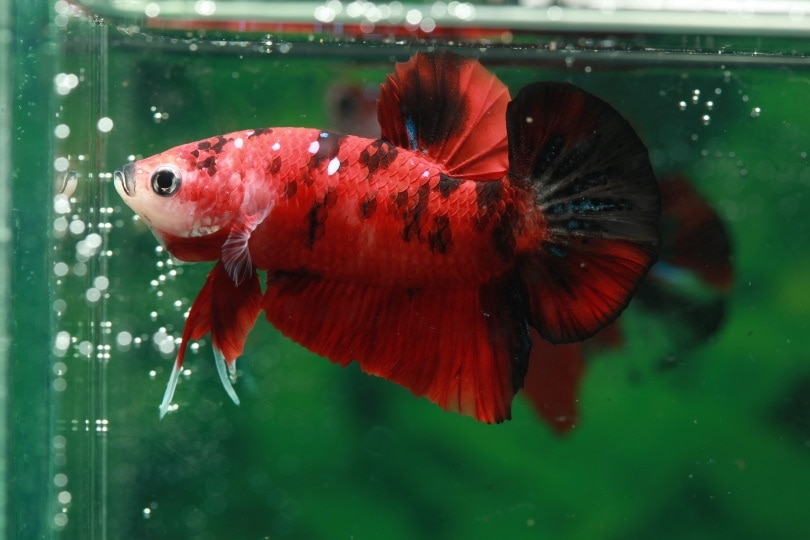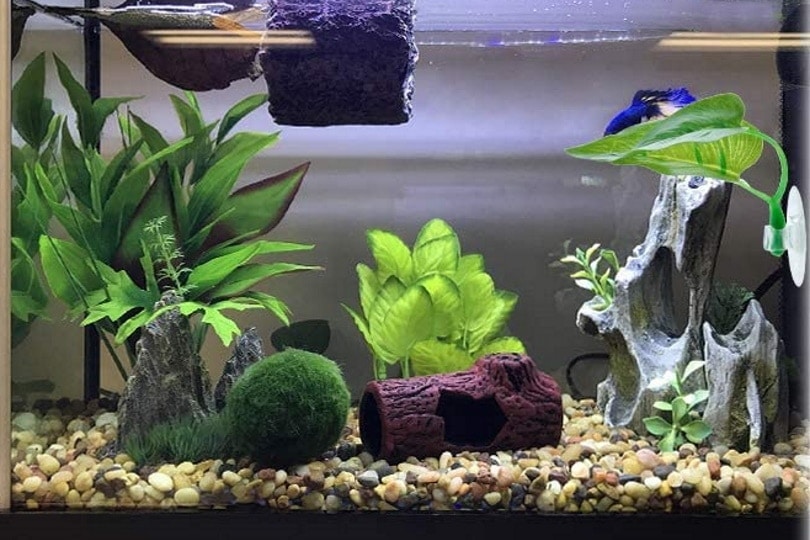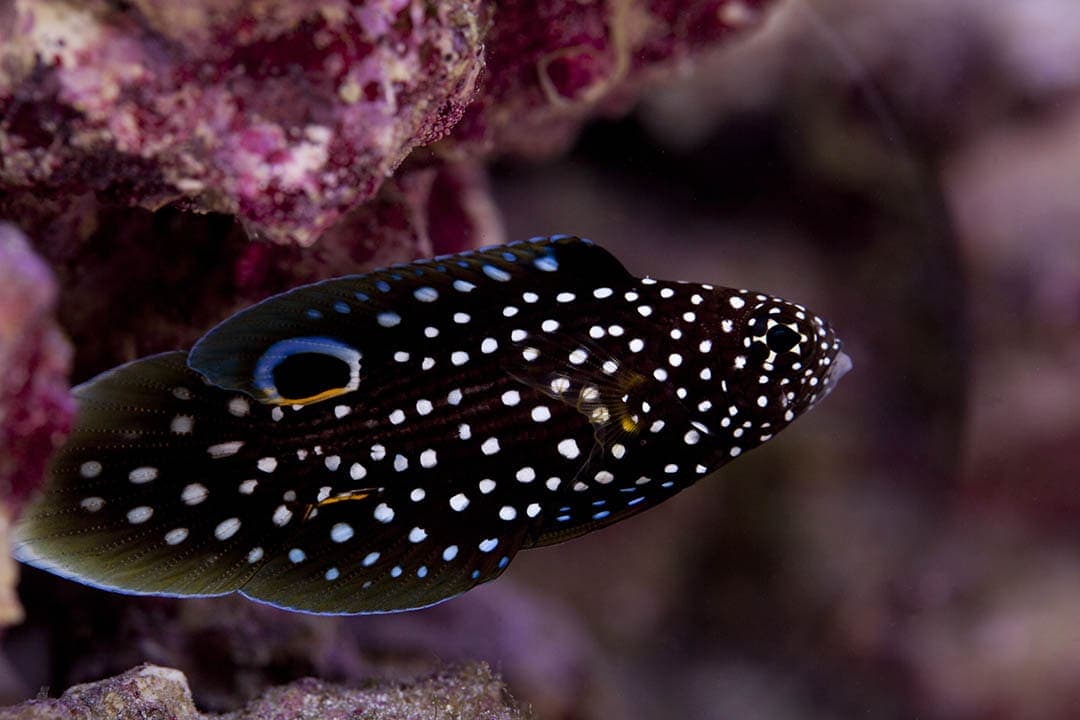Brown Algae In Betta Tank: What It Is & How To Remove It (Vet-Approved Advice)

Updated on

Click to Skip Ahead
If you’re starting to see a lot more “brown” in your betta fish tank, you’re probably dealing with a somewhat common, if not annoying, part of fish keeping: a brown algae outbreak. This slimy substance might start small but if left untreated, will soon overwhelm your betta tank, covering walls, plants, and substrate in an unpleasant brown coating.
The good news is that various types of brown algae aren’t dangerous to your betta fish. However, brown algae will make it more difficult for you to look at your betta for both health check purposes and for appreciating your fish in their colorful glory. Not to mention, it’s just plain unpleasant to look at! In this article, we’ll discuss what brown algae are, what causes them, and how to remove them. We’ll also talk about how you can stop brown algae outbreaks before they even start.
What Is Brown Algae?
The term “brown algae” can be confusing, because in a taxonomical sense, it refers to several marine organisms like certain species of kelp and some types of seaweed, some of which are consumed as food by humans. These brown algae are found only in marine environments in nature.
The brown algae that grows in betta tanks and other aquariums is a diatom, which is a microscopic, single-celled algae. Single diatoms link together to form chains, causing the visible brown algae that plague so many fish keepers. The cell walls of brown algae diatoms are made of a substance called silica, which occurs naturally in many rocks, sand, and consequently, water sources.
Brown algae are photosynthetic organisms that also rely on nutrients like nitrates, phosphorus, and silica to survive. In nature, they play a major role in both the carbon and urea cycle in bodies of water. These microscopic algae are present in almost all sources of water in the world, and they generate about 20 to 50 percent of the oxygen produced on the planet each year.
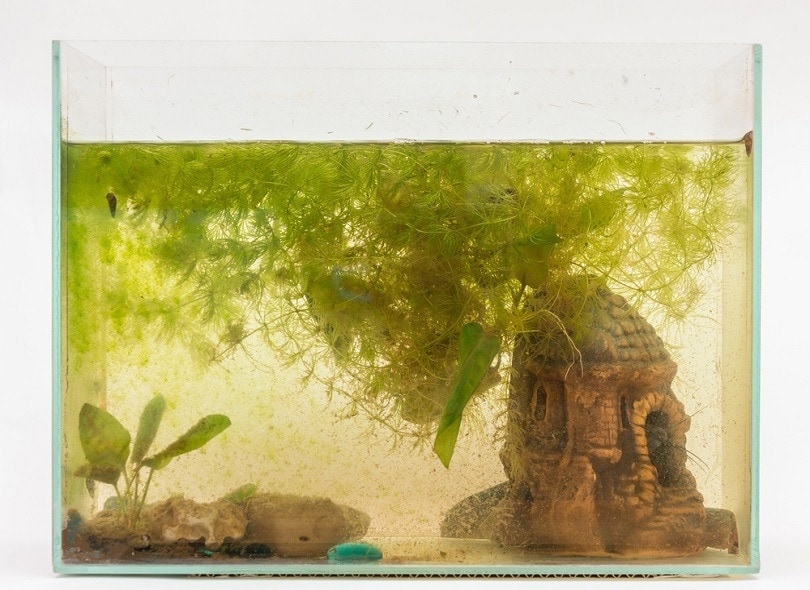
What Causes Brown Algae Outbreaks?
Because brown algae develop from materials that are naturally present in betta tanks, outbreaks often occur in new tank setups. Before the ecosystem in the aquarium reaches the right balance of bacteria and nutrients, brown algae often take advantage, feeding on the excess nutrition. Once enough bacteria are established, brown algae usually disappear because they no longer have a food source. In addition, they’re somewhat slower growing when compared to green algae, and therefore, eventually they are replaced by green algae in most aquatic environments.
If your betta tank isn’t new, or you are still dealing with brown algae in a new tank after some time, several factors could be responsible.
Too Much Silica
The primary source of silica that brown algae enjoy are sometimes found in tank glue, which is why this algae is so common in new aquariums. Once the silicates in tank glue run out, the algae blooms typically slow down and eventually disappear.
Another source of silica entering your aquarium includes the substrate you place in your aquarium, as some forms of aquarium substrates may have naturally occurring silica in them.
Because silica is a major component of sand, using sand as your tank’s substrate can contribute to a brown algae outbreak as well.
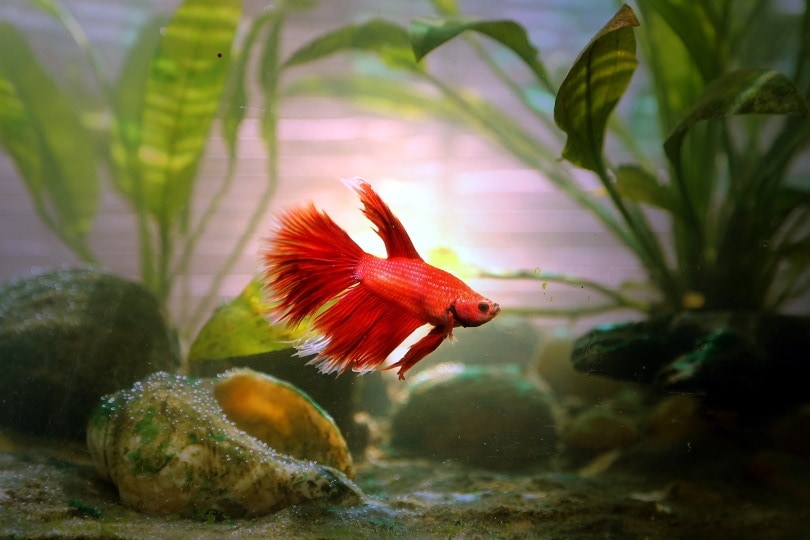
Too Many Nutrients
Besides too much silica in your tank, brown algae outbreaks can also happen when the nutrient balance in the water is off. Brown algae feed on nitrates and phosphorus, two nutrients that are always present in aquarium habitats but need to be carefully controlled and balanced.
The main culprits of excess nutrients in a betta tank are overfeeding your betta fish and not cleaning the tank properly. When you feed your betta fish more than they can eat, all the extra food remains in the tank, allowing the excess nutrients to leak into the water.
Tanks that are dirty or have poor filtration are also prone to nutrient imbalances. Overcrowding your tank with too many fish, especially combined with lack of cleaning and poor water flow, is another reason for excess nutrients.
Too Little Light
Lighting imbalances are often listed as a cause of brown algae outbreaks although there is debate over how true this is. The thinking is that when aquariums don’t get enough light, brown algae can outgrow the other plants in the tank because they have a lower light requirement and can efficiently grow in some light ranges that other plants cannot thrive in.
It is important to note that too much light can also be a bad thing, because it can easily cause a bloom of green algae.
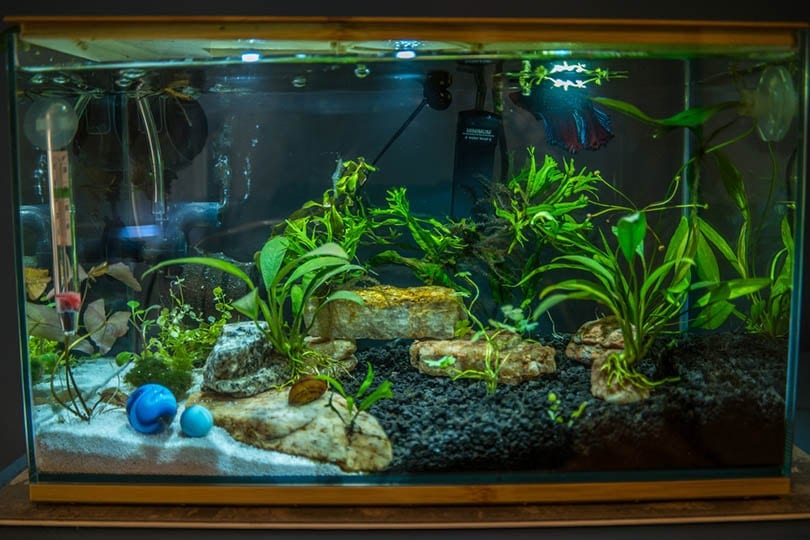
How To Remove Brown Algae From a Betta Tank
No matter what’s causing your brown algae outbreak, you’d really like to get rid of the ugly mess before your aquarium plants bite the dust. So, how do you remove brown algae from your betta tank?
Well, if your brown algae outbreak is happening because you’re establishing a new tank, you could just wait. These types of outbreaks will end on their own once bacteria and other plants start using up all the nutrients the brown algae need.
If you’d rather not wait, or you think your outbreak has another cause, here are some good ways to remove brown algae from your betta tank.
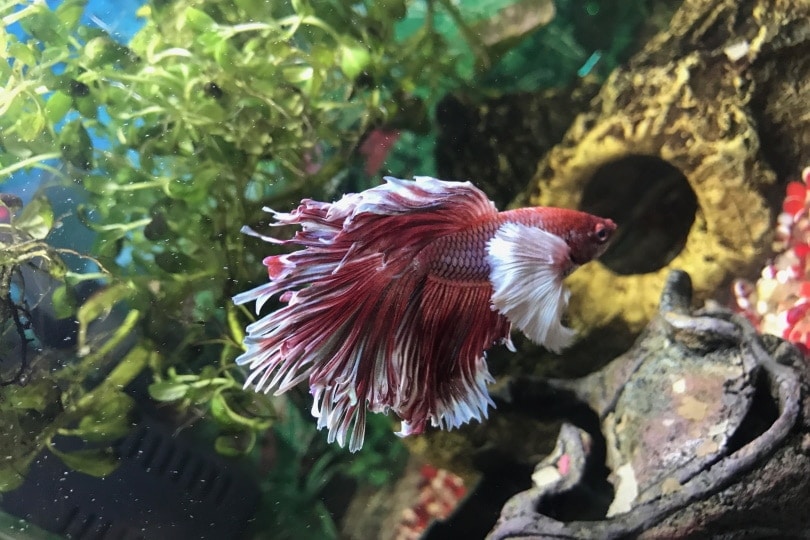
Start Scrubbing
One of the most effective ways to remove brown algae is simply by cleaning it off the aquarium surfaces. Brown algae are easily removed from aquarium walls by wiping with a soft sponge or rag. Even live aquarium plants can be gently wiped free of brown algae spots. Removing brown algae from your tank substrate is also possible but the method will depend on what type of substrate you have.
For a sand substrate, just scrape off the algae-covered top layer of sand and discard it.
For gravel substrate, the best plan is to use an aquarium vacuum to clean off the rocks. If you find that the algae are sticking tight to the rocks, you can also remove the dirty gravel from the tank to wash it by hand and then return it.
Any fake plants or other aquarium decorations should be removed from the tank for cleaning. Scrub them down with a toothbrush or other small cleaning brush. You can also soak the items in a dilute bleach solution (1 part bleach to 20 parts water) to ensure all the algae are removed.
Please keep in mind that this dipping method will focus on ridding your plants of potential hitchhikers and prominent algae, but algae can still show up in your aquarium due to other factors. You should not dip the plants for an excessive length of time. Consider the following guidelines:
- Thinly leaved/delicate plants, and more sensitive stem plants – 90 seconds (1 min 30 seconds)
- Most other plants – 120 seconds (2 minutes)
- Exceptionally hardy plants (Anubias species, Java Ferns) – 150 seconds (2 mins 30 seconds)
You should have a separate bucket with dechlorinated water ready before you dip your plants. Be sure the plants are thoroughly rinsed and soaked in the dechlorinating solution before returning them to your betta tank.
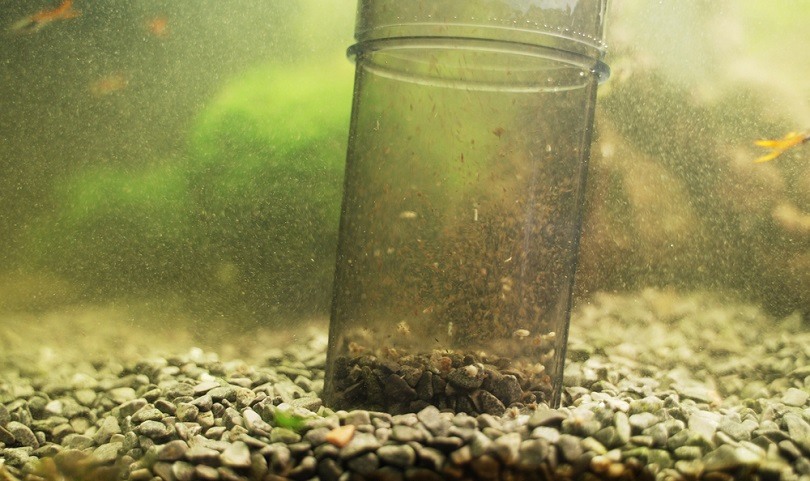
Add An Algae-Eating Tank Mate
Certain fish, snail, and shrimp species love nothing better than a nice meal of brown algae. However, betta fish can be temperamental and not all will be accepting of a tank mate. If your betta is on the mellower side, you could consider adding a tank mate who’ll clean up the brown algae.
An algae-eating snail, such as the Nerite snail, is generally the best choice for a betta tank mate. Bettas may decide a shrimp makes for a tasty snack, and generally speaking, snails are a better choice than shrimp for algae control in a betta’s tank. If your aquarium is large enough to support a small school of Otocinclus catfish, they are the best choice for an algae eater.
Add More Plants
Because brown algae and tank plants compete for the same nutrients, adding more plants to your tank can help end an outbreak. As the plants consume more and more of the nutrients, the brown algae will die off.
Keeping plenty of plants in your tank can also help to prevent further brown algae outbreaks.
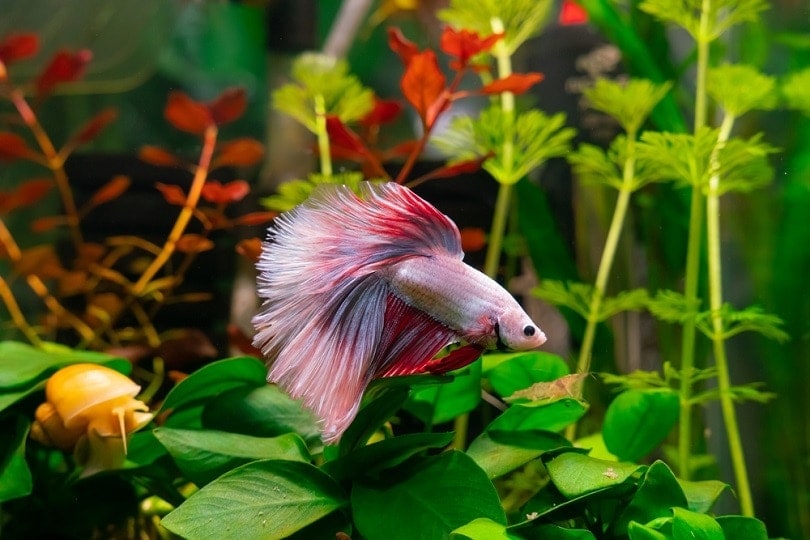
Correct The Lighting
Even if lighting issues don’t contribute to brown algae outbreaks, providing the right lighting for your tank will benefit both your betta fish and your plants. And it might just help stop your brown algae outbreak too. A light that’s appropriate for the plants in your aquarium should be on a 14:10 schedule in a betta’s tank (this means 14 hours of “day” followed by 10 hours of “night”).
Use Special Filtration
You can add special filters to your tank’s filtration system that will remove silica and phosphates from the water. Without these nutrients, brown algae will essentially starve to death and the outbreak will end. However, when using such filtration, be especially mindful about your aquarium plants, as they too will be deprived of nutrients.
Make sure your tank filtration system is checked and cleaned regularly, especially when you are dealing with an algae outbreak. Clogged filters can make your outbreak worse by contributing to bad water flow and not removing the excess nutrients as they should.
If you continue to deal with brown algae outbreaks, you may need to continue using the more advanced filters to help prevent further trouble.
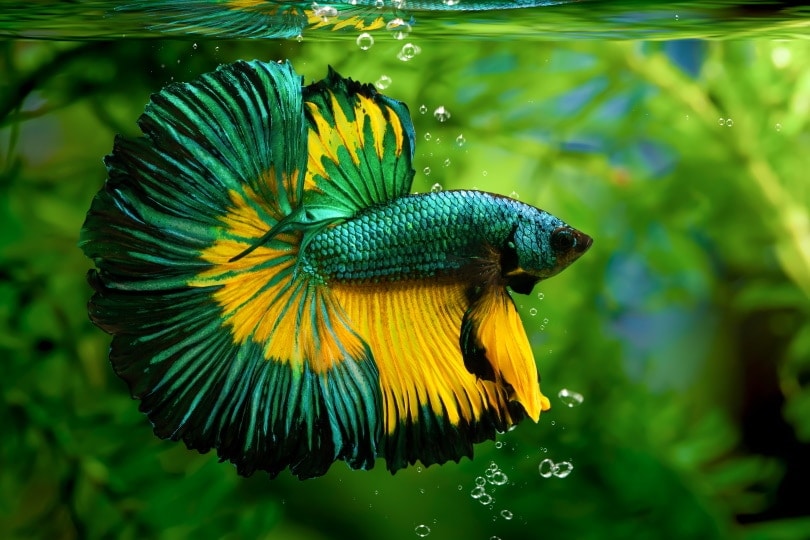
Use a UV Sterilizer
UV sterilizers shine UV light into your betta tank, killing off brown algae in the water before it can attach itself to surfaces and start spreading. The UV light won’t harm your betta fish or any other plants in your tank.
UV sterilizers are more expensive algae removing options than others we’ve discussed. However, they can be quite effective and are also useful for preventing harmful bacteria in your tank.
Use Chemicals
As a last resort, because more natural methods are always preferable, you can use chemicals to remove your brown algae. These chemicals generally work by stimulating bacteria to grow and use up all the brown algae’s nutrients until they die off. These shouldn’t harm your betta fish although there’s always a slight risk anytime you introduce something that changes the makeup of your tank ecosystem.

Preventing Brown Algae Outbreaks
Now that you’ve removed all the brown algae from your betta tank, how do you keep it from coming back again? While not every brown algae outbreak is preventable, there is a lot you can do to try and keep them from happening.
Use The Right Water (And Change It Regularly)
Rather than filling your betta tank with tap water that may contain pesky silica, try using either distilled or reverse osmosis water. Both water sources are treated to remove impurities, including silica.
Changing your tank’s water regularly will help prevent nitrates and phosphorus from building up, making it harder for brown algae to build up as well. Make sure not to change more than 35% of the water in your tank at a time to prevent stressing out your betta fish.
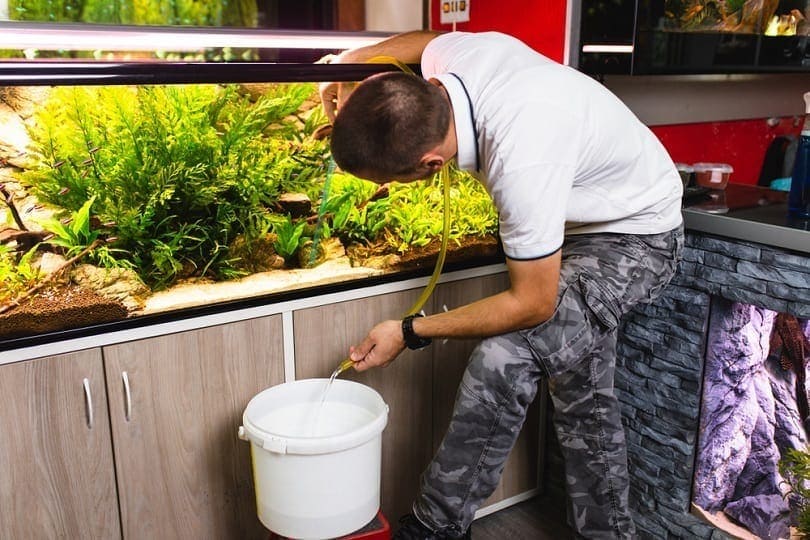
Keep Your Tank Water Filtered and Moving
Make sure you have a filtration system big enough to handle the needs of your betta tank. The right filter will be labeled to work with the gallon size of your betta tank. Keep your filter clean and, if necessary, add special filters like we already discussed, to help remove brown algae fueling substances from your tank water.
Making sure your tank has adequate water flow will make it harder for brown algae to attach to surfaces. This gets trickier with a betta tank because many bettas can’t handle strong currents in their tanks. You might have to experiment to find the right mix of flow to control brown algae while not making your betta feel like they’re swimming on a treadmill!
Avoid Silicates
We’ve already discussed how to avoid silicates in your tank water sources but silica can make its way into your tank in other ways as well. Some types of aquarium sand or rocks can also contribute silica to the tank. Read labels on any products you add to your aquarium to make sure they don’t have a lot of silica.
Don’t Overfeed
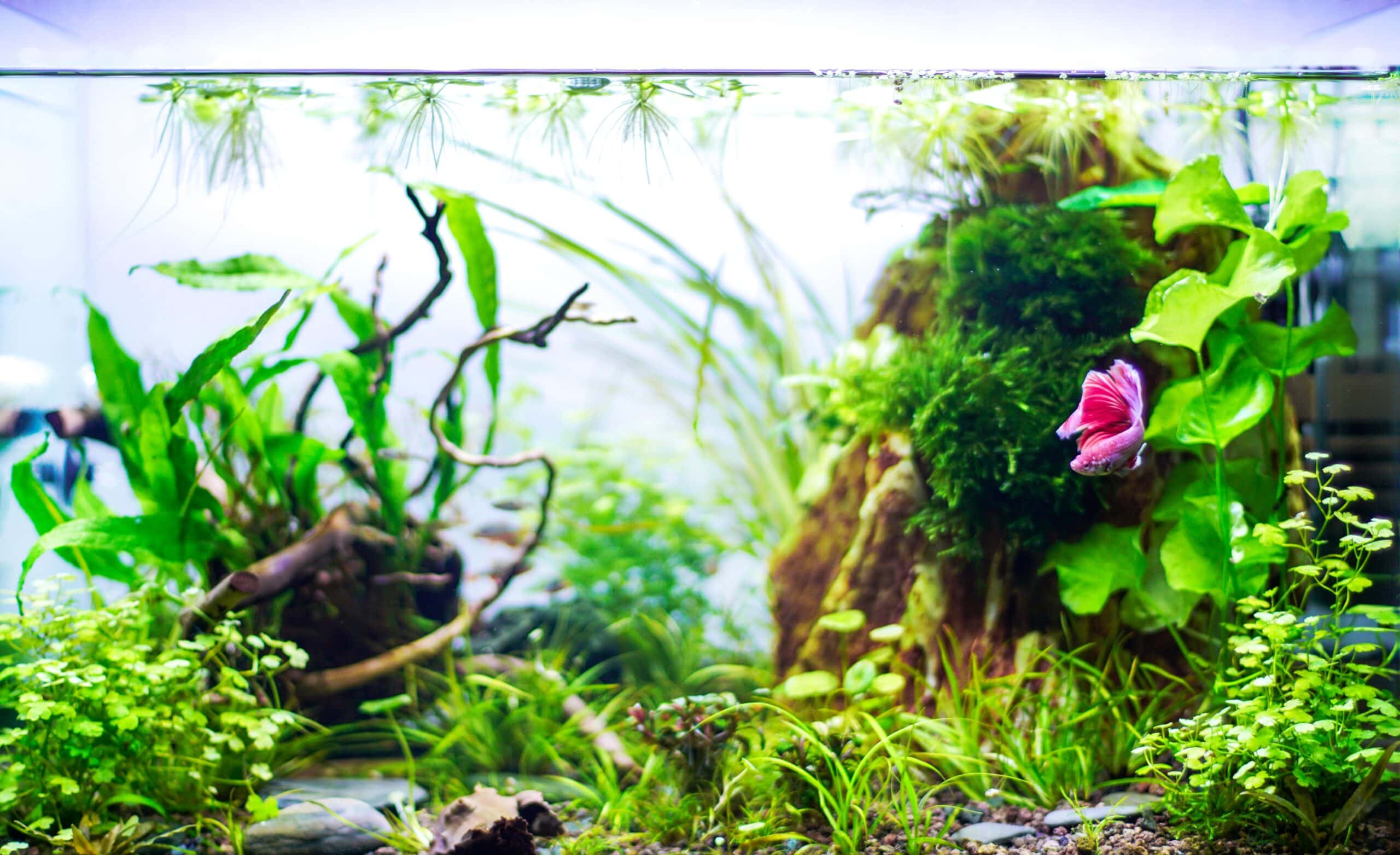
The recommended amount to feed your betta fish is 2-4 pellets or freeze-dried food sources 1-2 times per day. Their stomach is roughly the size of either one of their eyes. Monitor your betta to make sure they eat all their food.
If they continually don’t finish their meals, the uneaten food will build up in the tank, filling the water with those excess nutrients we talked about that can spark a brown algae outbreak. Be mindful that your betta might have a depressed appetite if the aquarium they are in is too cold for them. As tropical fish, their metabolism works best in tropical temperatures.
Keep Using Your UV Sterilizer
UV sterilizers can not only help stop brown algae outbreaks but can prevent them as well. A good UV sterilizer can help maintain the overall health of your tank and your betta fish by killing off algae and dangerous bacteria.
Final Thoughts
Brown algae outbreaks are simply part of life as an aquarium keeper. While brown algae may not hurt your betta fish, you still don’t want it around. Removing brown algae is only the first step towards solving the problem.
Brown algae outbreaks are often a sign that something is off balance with your betta tank overall. Finding out what’s causing your brown algae outbreak will help you prevent future issues and ensure your betta fish has the safest and healthiest living environment. Not to mention you won’t have to stare at ugly brown slime all over your betta tank anymore!
Featured Image Credit: Pras1107, Shutterstock



